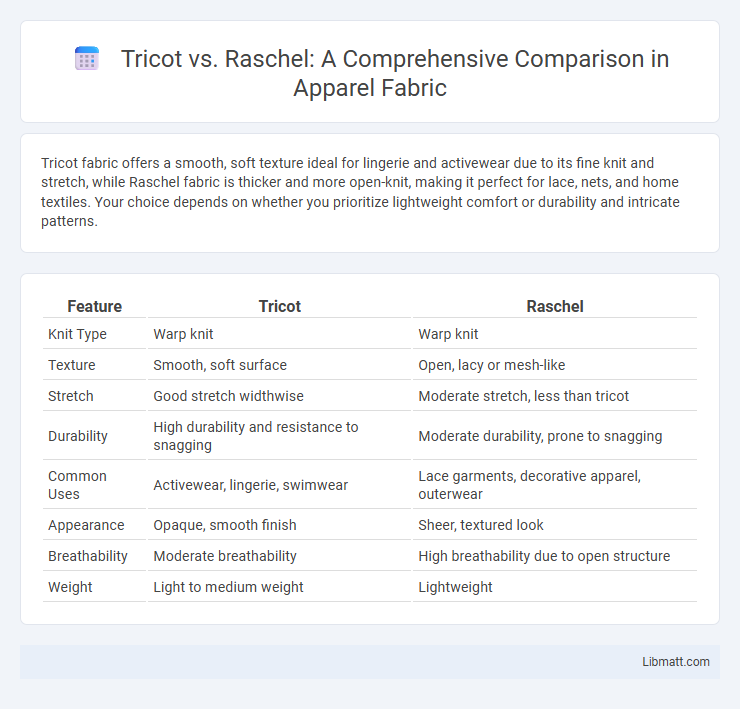Tricot fabric offers a smooth, soft texture ideal for lingerie and activewear due to its fine knit and stretch, while Raschel fabric is thicker and more open-knit, making it perfect for lace, nets, and home textiles. Your choice depends on whether you prioritize lightweight comfort or durability and intricate patterns.
Table of Comparison
| Feature | Tricot | Raschel |
|---|---|---|
| Knit Type | Warp knit | Warp knit |
| Texture | Smooth, soft surface | Open, lacy or mesh-like |
| Stretch | Good stretch widthwise | Moderate stretch, less than tricot |
| Durability | High durability and resistance to snagging | Moderate durability, prone to snagging |
| Common Uses | Activewear, lingerie, swimwear | Lace garments, decorative apparel, outerwear |
| Appearance | Opaque, smooth finish | Sheer, textured look |
| Breathability | Moderate breathability | High breathability due to open structure |
| Weight | Light to medium weight | Lightweight |
Introduction to Tricot and Raschel Fabrics
Tricot fabrics are lightweight, smooth, and characterized by their fine knit with a distinct diagonal pattern, commonly used in lingerie, activewear, and linings for their elasticity and breathability. Raschel fabrics are more textured and open-knit, featuring intricate lace-like patterns, often utilized in outerwear, curtains, and decorative applications due to their durability and ornamental appeal. Both Tricot and Raschel knits are warp knitting processes, but Tricot emphasizes flexibility and softness, while Raschel prioritizes structured designs and heavy-duty uses.
Historical Background of Tricot and Raschel
Tricot knitting, developed in the early 20th century, emerged as a fine, warp-knit fabric widely used in lingerie and sportswear due to its smooth texture and elasticity. Raschel knitting, patented by Joseph Raschel in the 19th century, is characterized by its open, complex, and often decorative warp-knit structures, making it ideal for lace, nets, and industrial textiles. Both Tricot and Raschel have evolved with advancements in warp knitting technology, influencing various textile applications from fashion to technical fabrics.
Key Differences in Knitting Techniques
Tricot uses a weft knitting technique producing fine, smooth fabrics with a flat, consistent surface ideal for lingerie and linings. Raschel knitting employs warp knitting with open, mesh-like patterns, creating textured, stretchable fabrics commonly used in lace and netting. The key difference lies in tricot's single needle bar and uniform loops versus raschel's multiple needle bars and complex, patterned structures.
Material Composition and Yarn Types
Tricot fabric is typically made from smooth, fine synthetic fibers such as nylon or polyester, resulting in a soft and lightweight texture ideal for lingerie and activewear. Raschel fabric often uses a blend of heavier yarns, including cotton, polyester, or wool, producing a more open and textured knit suitable for lace, curtains, and upholstery. Understanding these material differences allows you to choose the fabric best suited for durability, stretch, and aesthetic preferences.
Fabric Structure and Appearance
Tricot fabric features a smooth, fine, and tightly knitted structure with distinct vertical wales, providing excellent stretch and durability. Raschel fabric is characterized by an open, lace-like knit with intricate patterns and a more textured surface, often used for decorative and breathable textiles. The dense, uniform appearance of tricot contrasts with the porous, ornamental look of raschel, influencing their specific applications in clothing and home textiles.
Performance and Durability Comparison
Tricot fabrics exhibit superior stretch and flexibility, making them ideal for activewear that demands high performance and comfort. Raschel knits offer enhanced durability with a more structured texture, suited for applications requiring robust wear resistance like outerwear and upholstery. Your choice between tricot and raschel depends on whether flexibility or long-lasting durability takes priority in the fabric's intended use.
Common Applications and Uses
Tricot fabric is widely used in sportswear, lingerie, and automotive interiors due to its smooth surface, excellent stretch, and durability, making it ideal for garments requiring comfort and flexibility. Raschel fabric, characterized by its open lace-like patterns, is commonly found in home textiles, such as curtains, blankets, and decorative fabrics, as well as in lace apparel and industrial coverings. Your choice between Tricot and Raschel depends on the specific application's need for stretchability versus intricate design and texture.
Advantages of Tricot Fabrics
Tricot fabrics offer superior stretchability and softness, making them ideal for activewear and lingerie. Their smooth surface enhances comfort and aesthetic appeal, while excellent breathability ensures moisture-wicking properties. Tricot's durable knit structure resists runs and tears, providing long-lasting wear compared to raschel fabrics.
Benefits of Raschel Fabrics
Raschel fabrics offer excellent durability and a firm texture, making them ideal for applications where strength and resilience are required, such as lace, nets, and upholstery. Their open-knit construction provides superior breathability and moisture-wicking properties, enhancing comfort in apparel and technical textiles. If you're choosing between Tricot and Raschel, selecting Raschel fabric ensures your product benefits from enhanced structural stability and intricate design versatility.
Choosing Between Tricot and Raschel: Which is Best?
Choosing between tricot and raschel fabrics depends on the end-use requirements, as tricot offers a smooth, lightweight, and stretchable texture ideal for activewear and lingerie, while raschel is thicker with an open, lace-like appearance suited for outerwear and decorative purposes. Tricot's fine knit structure provides excellent moisture management and durability, making it a preferred choice for performance garments, whereas raschel's unique knit pattern enhances aesthetic appeal and breathability. Evaluating factors such as stretch recovery, fabric weight, design complexity, and garment function helps determine which fabric aligns best with specific apparel needs.
Tricot vs raschel Infographic

 libmatt.com
libmatt.com